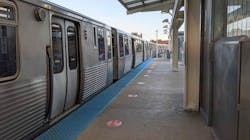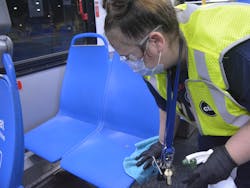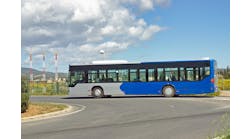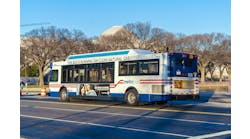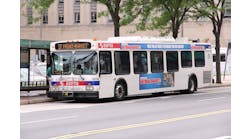Public Transit Q&A: How the CTA has operated during COVID-19
By: Tim Bruns
The Chicago Transit Authority (CTA) recently responded to several questions from Traffic & Transit regarding the agency's response to COVID-19 and how operations have continued since the start of the pandemic. The following is an edited transcript of that Q&A. Responses were given by CTA spokesperson Steve Mayberry.
T&T: Can you describe how the COVID-19 pandemic has impacted transit operations since March?
CTA: COVID-19 has had a monumental impact on every aspect of daily life, including public transit. Like transit agencies across the country, CTA has seen unprecedented drops in ridership and revenue. But throughout the pandemic, CTA took seriously its role as an essential service, providing as many buses and trains as possible. Our hard-working bus and rail operators, maintenance personnel, and other dedicated staff made it possible for first responders and essential workers to do their jobs, including the doctors, nurses, other medical personnel, grocery store workers, manufacturing workers and others who rely on CTA to get to work. At a time when only essential agencies and workers were asked to show up and support the community, CTA kept buses and trains moving for those who need them the most.
T&T: How have things changed for CTA operations since the start of the pandemic?
CTA: Throughout the COVID-19 crisis, CTA has kept buses and trains running on a normal schedule. In fact, we’re one of the few transit agencies in the country that did not reduce scheduled service during the pandemic. In fact, on some bus routes and train lines we increased frequency or added longer buses and trains, to help reduce overcrowding and ensure those who rely on most could still get where they needed.
T&T: What would you say is the biggest challenge for the CTA right now as a result of the coronavirus pandemic?
CTA: The biggest challenge has been mastering the balancing act: How do we provide service that’s essential to hundreds of thousands of Chicagoans while providing the healthiest environment for both customers and employees? We’ve met that challenge, thus far, through rigorous cleaning measures for buses, trains and stations; a commitment to providing as much service as possible; and extensive promotion of healthy travel habits. We’ve focused heavily on customer awareness and education, on everything from the importance of properly wearing a mask to practicing social distancing whenever they are on CTA vehicles or property.
T&T: In New York, the MTA launched a UV light pilot program to kill coronavirus on public transit. Is the CTA looking into adopting something like this? Any other plans in the works for combating the virus on CTA vehicles?
CTA: Even before the pandemic, CTA had one of the most rigorous cleaning regimens of any U.S. transit agency. Now more than ever, we are looking at new ways to provide an even cleaner, safer CTA travel environment. As such, we are in communication with officials at MTA regarding their piloting of UV lighting. We continue to seek out industry best practices and latest technologies and measures to further enhance cleaning efforts. For example, we recently added two new technologies: electrostatic sprayers that produce a fine-mist that clings to nearly every surface to ensure a more thorough cleaning, as well as use of an antimicrobial surface coating designed to prevent viruses from attaching to surfaces. We’ve also recently introduced our new Railcar Refreshers program—dedicated teams that are tasked with cleaning high-touch surfaces of in-service trains at all CTA rail terminals. We have also implemented new, mobile power-washing teams that clean 50-75 rail stations per week.
T&T: What are some of the safety measures the CTA has taken to promote social distancing on public transit vehicles and stations? What are some of the messages for the traveling public?
CTA: We are educating and encouraging our customers to act as our partners in the effort to slow the spread of the coronavirus and to continue the practices they’ve been following for the last several months, like wearing masks, social distancing, and washing their hands, etc. We have utilized a number of different mediums to engage our customers regarding the State Order to wear masks in public and maintain 6 ft of distance whenever possible, including social media, the CTA website (transitchicago.com), audio announcements in stations and on vehicles, extensive vehicle signage, social distancing floor decals, and added signage throughout rail stations; and the distribution of more than 12,000 free CTA Travel Healthy kits to date, which include a 2 oz. bottle of hand sanitizer, a reusable cloth mask and a healthy riding tips guide. We have also made changes to aspects of our day-to-day operations, such as real-time camera crowd monitoring at high-ridership rail stations, service monitoring and bus crowding management, which implements passenger limits aboard CTA buses. We have also introduced a Ridership Information Dashboard, a new tool to help customers better plan their transit trip with features like a bus crowding report, which provides an overview of available capacity for each of CTA’s 127 bus routes.
T&T: How has the pandemic impacted bus and train capacity? Have there been limits placed on how many people can ride in a single bus or train car?
CTA: CTA has set capacity limits for vehicles: 15 for a standard 40-ft bus, 22 for a rail car, and a 60-ft articulated bus. We’ve also implemented bus crowding management, which gives bus operators the authority to bypass certain bus stops if their bus is becoming crowded.
T&T: In what ways are the CTA's employees, particularly drivers, being equipped to prevent the spread of COVID-19? Are they given masks, sanitizer, protective gear, etc.?
CTA: Since the beginning of the pandemic, CTA has worked closely with the Chicago Department of Public Health (CDPH), the Illinois Department of Public Health (IDPH), and the Center for Disease Control and Prevention (CDC) and has taken extensive measures to protect its employees. All CTA bus and rail operations and maintenance employees have been provided with proper personal protective equipment per guidance from the CDPH and CDC, including cloth masks, gloves, protective eyewear, and hand sanitizer.
The CTA also directed Traffic & Transit to the extensive discussion of sanitation procedures for buses and trains found here on the agency's website, which states the following:
"Our No. 1 focus has been on providing the cleanest travel environment possible for our riders and employees. We already have one of the most rigorous cleaning regimens of any U.S. transit agency and we remain committed to looking for new ways to make it even stronger."
About The Author: Bruns is associate managing editor of Traffic & Transit.
